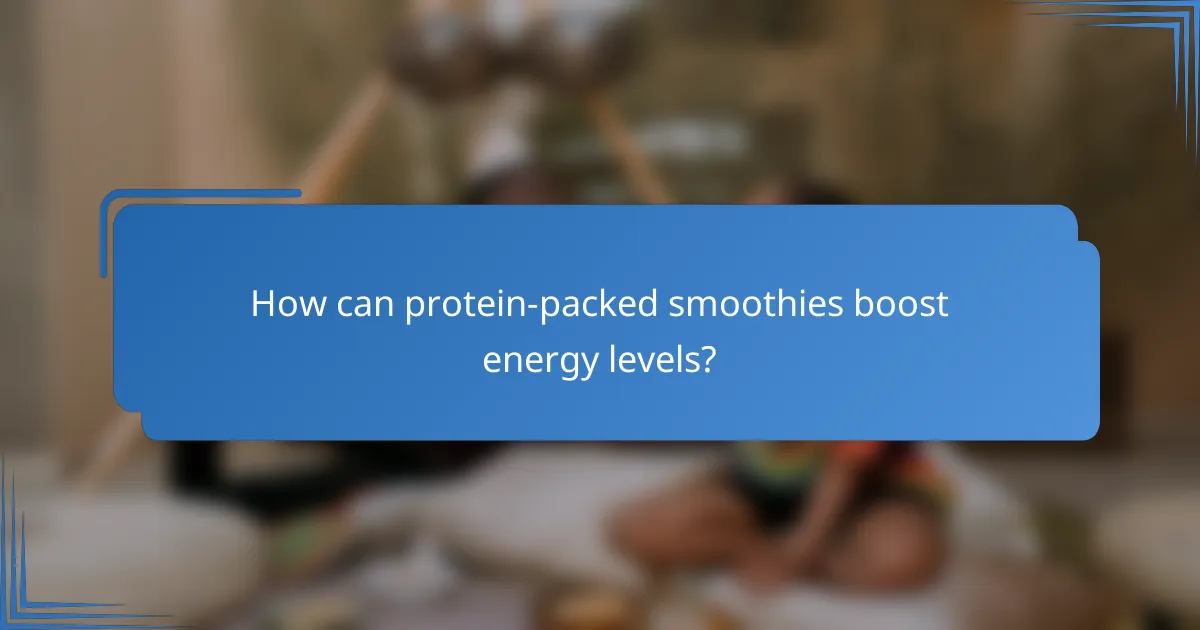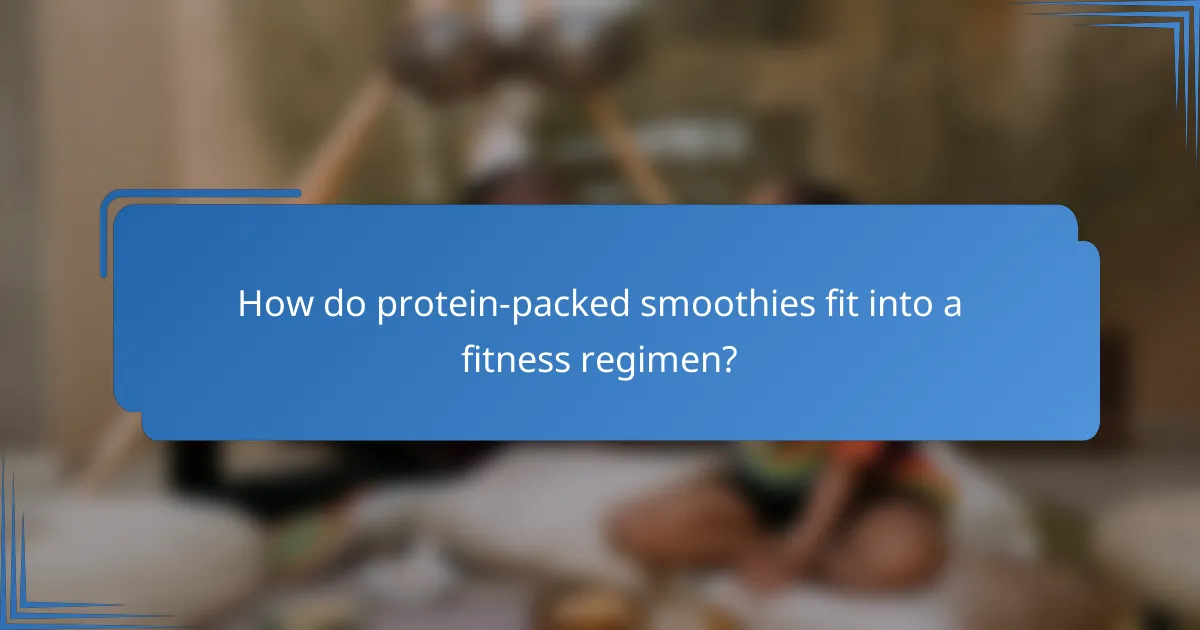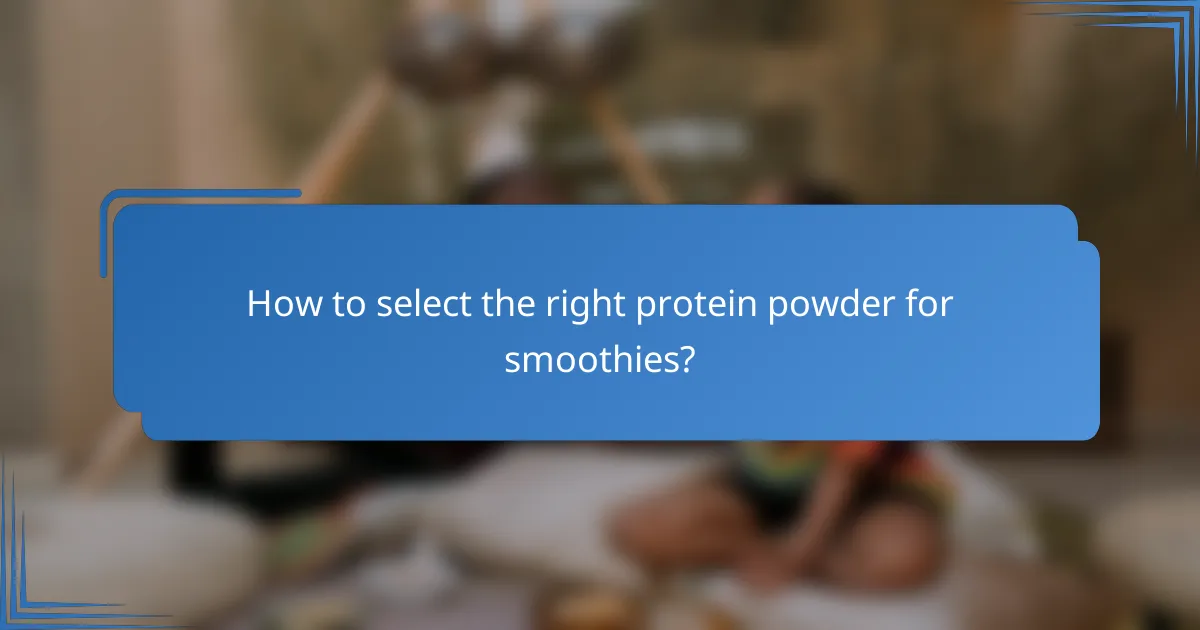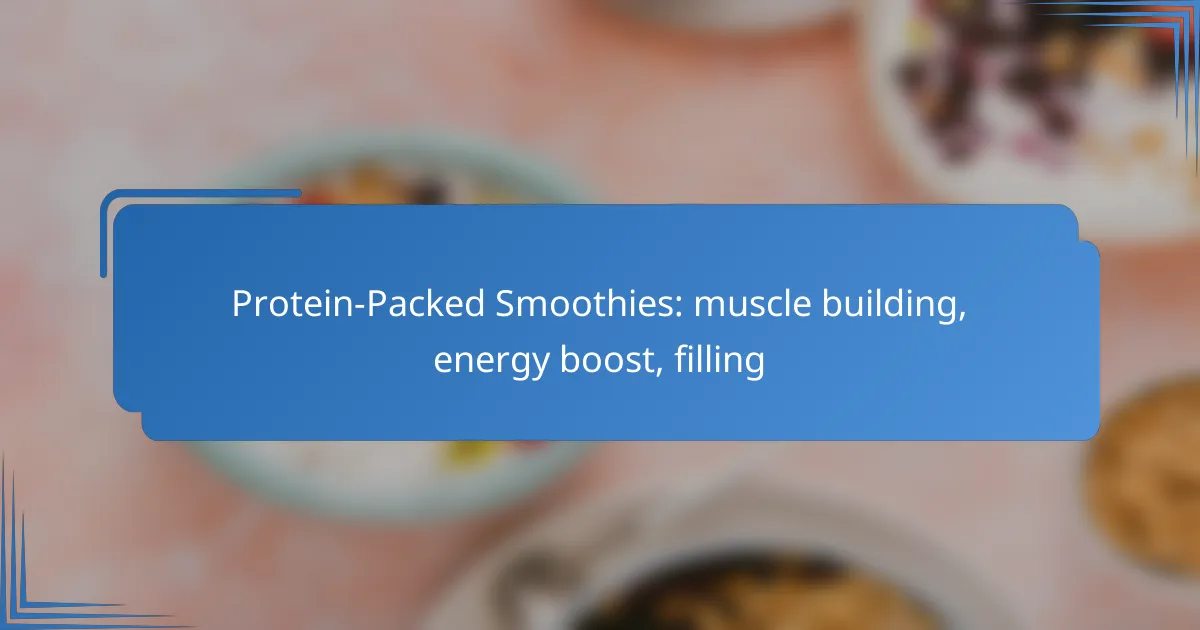Protein-packed smoothies are an excellent way to support muscle building and recovery while providing a sustained energy boost. By combining high-quality protein sources with nutrient-dense ingredients, these smoothies not only fill you up but also fuel your workouts effectively. Incorporating items like whey protein, Greek yogurt, and nut butters can enhance both the protein content and the overall taste of your smoothie.

What are the best protein-packed smoothie recipes for muscle building?
The best protein-packed smoothie recipes for muscle building combine high-quality protein sources with nutrient-dense ingredients. These smoothies not only support muscle recovery but also provide sustained energy for workouts.
Chocolate Banana Protein Smoothie
The Chocolate Banana Protein Smoothie is a delicious way to boost your protein intake while enjoying a sweet treat. Blend together one ripe banana, a scoop of chocolate protein powder, a tablespoon of almond butter, and a cup of unsweetened almond milk for a creamy texture.
This smoothie offers a good balance of carbohydrates and protein, making it ideal for post-workout recovery. Consider adding a handful of spinach for extra nutrients without altering the flavor significantly.
Berry Spinach Protein Smoothie
The Berry Spinach Protein Smoothie is packed with antioxidants and essential vitamins. Combine a cup of mixed berries (like strawberries, blueberries, and raspberries), a scoop of vanilla protein powder, a handful of fresh spinach, and a cup of coconut water for hydration.
This smoothie is not only refreshing but also supports muscle repair with its protein content and provides energy from the natural sugars in the berries. You can enhance its creaminess by adding a few slices of avocado.
Peanut Butter Oatmeal Smoothie
The Peanut Butter Oatmeal Smoothie is a filling option that combines protein and fiber. Blend together half a cup of rolled oats, a tablespoon of peanut butter, a scoop of protein powder, and a cup of milk (dairy or plant-based) for a hearty drink.
This smoothie is perfect for breakfast or as a meal replacement, offering sustained energy throughout the day. To sweeten it naturally, consider adding a banana or a drizzle of honey, but keep an eye on the overall sugar content.

How can protein-packed smoothies boost energy levels?
Protein-packed smoothies can significantly enhance energy levels by providing essential nutrients that fuel the body. These smoothies combine proteins, healthy fats, and carbohydrates, which work together to sustain energy throughout the day.
Increased nutrient absorption
Protein-packed smoothies facilitate increased nutrient absorption by combining various ingredients that complement each other. For instance, adding fruits rich in vitamin C can enhance the absorption of iron from leafy greens included in the smoothie.
When blended, the ingredients break down into smaller particles, making it easier for the body to digest and utilize the nutrients. This process can lead to a more efficient energy release, keeping you energized longer.
Quick and convenient meal option
Protein smoothies serve as a quick and convenient meal option, perfect for busy lifestyles. Preparing a smoothie typically takes just a few minutes, allowing for a nutritious meal on the go.
To maximize energy, consider including a balance of protein sources, such as Greek yogurt or protein powder, along with fruits and vegetables. This combination not only satisfies hunger but also provides sustained energy without the crash associated with sugary snacks.

What ingredients enhance protein content in smoothies?
To enhance the protein content in smoothies, consider incorporating ingredients that are naturally rich in protein. Options like whey protein powder, Greek yogurt, and nut butters not only boost protein levels but also add flavor and texture.
Whey protein powder
Whey protein powder is a popular choice for increasing protein in smoothies due to its high biological value and fast absorption rate. Typically, a scoop contains around 20-30 grams of protein, making it an efficient way to meet daily protein needs.
When using whey protein, be mindful of the flavor profile of your smoothie. Unflavored or vanilla whey can blend well with fruits, while chocolate whey pairs nicely with nut butters. Start with one scoop and adjust based on your protein goals.
Greek yogurt
Greek yogurt is another excellent ingredient for protein-packed smoothies, offering about 10 grams of protein per 100 grams. It also adds creaminess and a tangy flavor that complements various fruits.
Opt for plain, unsweetened Greek yogurt to avoid added sugars. You can mix it with berries or bananas for a nutritious breakfast or post-workout snack. A half-cup serving is a good starting point for most smoothies.
Nut butters
Nut butters, such as almond or peanut butter, provide healthy fats and protein, typically around 7-8 grams per tablespoon. They contribute a rich flavor and can help keep you feeling full longer.
When adding nut butters, consider the overall calorie content of your smoothie. A tablespoon is usually sufficient, but you can adjust based on your dietary needs. Pair nut butters with fruits like bananas or apples for a delicious and filling combination.

What are the benefits of protein-packed smoothies for weight management?
Protein-packed smoothies can aid in weight management by promoting feelings of fullness and providing essential nutrients without excessive calories. These smoothies help control hunger and can be a convenient meal replacement or snack option.
Increased satiety
Protein is known to enhance feelings of fullness, which can reduce overall calorie intake. Smoothies that include protein sources like Greek yogurt, protein powder, or nut butter can keep you satisfied longer than those high in carbohydrates alone.
To maximize satiety, aim for a protein content of around 20-30 grams per smoothie. This can be achieved by combining various protein sources, ensuring you feel fuller and less likely to snack between meals.
Balanced macronutrient profile
A well-crafted protein-packed smoothie should contain a balance of protein, healthy fats, and carbohydrates. This balance supports sustained energy levels and prevents blood sugar spikes, which can lead to cravings.
Consider using a mix of ingredients: a scoop of protein powder, a handful of spinach, half a banana, and a tablespoon of almond butter. This combination provides protein, fiber, and healthy fats, creating a nutritious option that supports weight management effectively.

How do protein-packed smoothies fit into a fitness regimen?
Protein-packed smoothies are an excellent addition to a fitness regimen, providing essential nutrients for muscle building, energy, and satiety. They can be strategically consumed before or after workouts to enhance performance and recovery.
Pre-workout energy boost
Consuming a protein-packed smoothie before a workout can provide a significant energy boost. Ingredients like bananas, oats, and nut butter offer carbohydrates for quick energy, while protein sources such as Greek yogurt or protein powder help sustain muscle function during exercise.
A good pre-workout smoothie should ideally be consumed about 30 to 60 minutes before exercising. Aim for a balance of protein and carbohydrates, with a target of around 20-30 grams of protein and 30-50 grams of carbs to optimize performance.
Post-workout recovery
After a workout, protein-packed smoothies play a crucial role in recovery by replenishing nutrients and repairing muscle tissue. A smoothie rich in protein and healthy fats can help reduce muscle soreness and promote faster recovery.
For post-workout smoothies, include ingredients like whey protein, spinach, and berries. Aim for a protein intake of around 20-40 grams within 30 minutes after exercising to maximize recovery benefits. Adding a source of healthy fat, such as avocado, can further enhance nutrient absorption and satiety.

What are the best practices for making smoothies?
To create the best smoothies, focus on using high-quality ingredients and employing proper blending techniques. These practices enhance flavor, nutrition, and texture, ensuring a satisfying drink that supports muscle building and energy levels.
Choosing high-quality ingredients
Selecting high-quality ingredients is crucial for a nutritious smoothie. Opt for fresh fruits and vegetables, preferably organic, to maximize vitamins and minerals. Incorporate protein sources like Greek yogurt, protein powder, or nut butters to boost muscle-building potential.
Consider adding superfoods such as spinach, chia seeds, or flaxseeds for added health benefits. Aim for a balance of flavors and textures by mixing sweet fruits with creamy or nutty elements. Avoid overly processed ingredients that may contain added sugars or preservatives.
Proper blending techniques
Effective blending techniques can significantly improve the consistency and taste of your smoothie. Start by adding liquids first, such as water, milk, or juice, to help the blender operate smoothly. Follow with softer ingredients, then add harder items like frozen fruits or ice last.
Blend on a low setting initially, gradually increasing speed to ensure even mixing. Stop occasionally to scrape down the sides and check the texture. Aim for a creamy consistency without lumps, which typically takes about 30 seconds to a minute of blending.

How to select the right protein powder for smoothies?
Selecting the right protein powder for smoothies involves considering your dietary preferences, fitness goals, and any allergies. Key factors include the source of protein, amino acid profile, and additional ingredients like sweeteners or fillers.
Whey vs. plant-based protein
Whey protein is derived from milk and is known for its high biological value, meaning it is quickly absorbed by the body. It is an excellent choice for muscle building due to its rich content of essential amino acids, particularly leucine, which plays a crucial role in muscle repair and growth.
Plant-based protein, on the other hand, is sourced from various plants such as peas, rice, and hemp. It is suitable for those who are lactose intolerant or following a vegan diet. While it may have a slightly lower biological value compared to whey, combining different plant proteins can create a complete amino acid profile.
When choosing between whey and plant-based protein, consider your dietary restrictions and fitness objectives. If muscle gain is your primary goal and you have no dairy issues, whey might be the best option. For a more holistic approach or if you prefer a vegan diet, opt for a high-quality plant-based blend.
